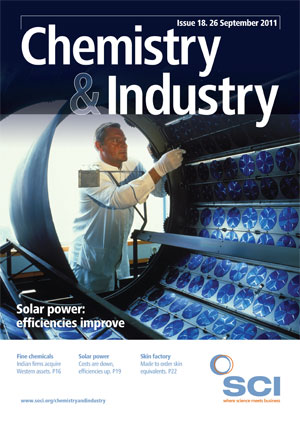The use of small-scale solar panels on rooftops in Europe is booming. Indeed, in June 2011 the director of Coventry Cathedral announced that the grade I listed building would be the first cathedral in the country, and possibly the world, to go ‘solar’.
This trend has been helped, in part, by the sharp fall in the cost of photovoltaic (PV) technology, a drop of 60% since mid-2008 according to a report1 by the United Nations Environment Programme (UNEP) on green investment published in July 2011. The report also predicts further cost reductions for solar technologies in future.
At the end of 2010, the installed PV capacity reached 40GW – with 16.6GW added during 2010 – producing some 50 Terawatt-hours (TWh) of electrical power/year, according to a report2 published by the European Photovoltaic Industry Association (EPIA) in May 2011. This could meet the electricity demands of a country the size of Greece or Switzerland. The performance of a solar cell is measured in terms of its efficiency at turning sunlight into electricity. According to EPIA, a typical commercial solar cell has an efficiency of 15%, which means that about a sixth of the sunlight striking the cell generates electricity. Improving efficiencies, while holding down the cost per cell, is an important goal of the PV industry.
R&D direction
As Mike Walls of Loughborough University’s Centre for Renewable Energy Systems Technology in the UK puts it: ‘The thrust of research into PV is to lower costs, either by simplifying manufacture, reducing material usage or increasing efficiency.’
PV cells use either crystalline silicon (c-Si) or photosensitive materials deposited in thin layers on a low-cost backing material such as glass, stainless steel or plastic. The former accounted for 86.5% of worldwide solar cell production in 2010, according to a report by solar market analysts Solarbuzz.3
c-Si cells are made from a single crystal of silicon (monocrystalline), from a block of silicon crystals (polycrystalline), or from ribbon sheets of silicon. Their efficiency ranges between 11 and 19%, according to EPIA. ‘c-Si is a mature technology and it dominates the market,’ explains Stuart Irvine, director of the Centre for Solar Energy Research at Glyndŵr University, UK.
The cost of c-Si fell dramatically over the past few years, thanks to high-volume manufacturing and a fall in silicon feedstock prices, he says.
‘The focus of research efforts now is on producing ever thinner silicon layers,’ says Irvine. ‘At present, they are around 200μm thick and break rather easily – both polycrystalline and single crystal silicon. The objective is to reduce thickness down to around 180 μm. Sharp, for example, is working on this.’
Efficiencies for the best cells are 20%, but this falls to 15–16% when cells are grouped together. In the lab, efficiencies can reach 25%, so there is some mileage in improving efficiency, Irvine continues. ‘Never write silicon off – it is a big industry and brings with it a lot of expertise and engineering skills,’ he says.
Thin-film technology
The manufacture of thin-film panels is cheaper than the more material-intensive crystalline technology, a price advantage that is counterbalanced by lower efficiency rates, from 4 to 11%, according to EPIA. Four types of thin-film panels are commercially available:
- amorphous silicon (a-Si);
- cadmium telluride (CdTe);
- copper indium gallium diselenide/disulfide (CIGS);
- multi-junction cells (a-Si/m-Si)
‘The big story over the past three years has got to be the rise of thin-film CdTe,’ says Walls. Thin-films are cheaper to produce than c-Si, and CdTe absorbs light more readily than silicon. ‘But when it is put on a glass substrate, defects are introduced and efficiency falls,’ Irvine explains. ‘So the maximum efficiency is not that much different to c-Si. The best lab result is 16.5% and this has not changed in the past 10 years. The best module was, until recently, around 10%.’

Walls agrees: ‘The reason behind First Solar’s success is costs are much lower even than Chinese suppliers of crystalline silicon, and efficiencies are increasing. It has produced a rise in efficiency of around 4.5% over four years. And every rise of 1% in efficiency is equivalent to a 10% reduction in costs.’
First Solar’s Brandon Mitchener explains company strategy: ‘First Solar’s founders abandoned silicon technology and opted for CdTe because of the ready availability of the main raw materials – at a time of silicon shortages and price fluctuations – and because of a combination of engineering and environmental advantages. Unlike c-Si, CdTe PV allows high-throughput mass manufacturing at relatively low cost, minimises use of natural resources, has a fast energy payback time and small carbon footprint, and is easy to recycle.’
Analysts following First Solar are positive. In May 2011, Morningstar Equity Research analysts wrote: ‘The company’s unique CdTe technology currently has a 20% structural cost advantage over its c-Si competitors.’ They also believe First Solar’s costs will fall ‘as fast as, or faster than, c-Si in the coming years, assuming silicon costs are constant.’
Research continues into improving CdTe thin-films. Irvine’s group at Glyndŵr University is developing metal organic chemical vapour deposition (MOCVD) manufacturing techniques. According to Irvine, MOCVD offers lower manufacturing temperatures and the opportunity to engineer materials’ chemistry. ‘We can look at different compositions using cadmium sulfide and cadmium zinc sulfide combined with CdTe,’ he explains.
Other efforts focus on reducing the thickness of the CdTe absorber layer, which is currently around 4–5μm. Walls’ group at Loughborough University, for example, is aiming for 2μm. ‘We are using sputtering as the deposition technique as it can offer highly uniform deposition,’ he says.
CIGS offers some of the brightest hopes for the future of thin-film PV and also some of its greatest problems, according to industry analyst NanoMarkets in its 2009 report.4 Potentially, CIGS panels could provide the high conversion efficiencies of c-Si with all the advantages of a thin-film material: flexibility, manufacturability and low weight. But, CIGS is a complex material the characteristics of which are not yet well understood. The report concludes that developments in materials will be key for future success.
‘CIGS have higher efficiency [than CdTe],’ explains Irvine. ‘But, whereas CdTe can be laid down with its two constituents spread equally along the film, it can be difficult to get a uniform spread of CIGS’ four constituents, so volume manufacturing is harder.’
Flexible cells
Rather than using a rigid substrate like glass for the thin films, another option is to deposit the active material on a flexible substrate, such as plastic or stainless steel. There are a number of companies producing flexible CIGS modules, such as Global Solar and Ascent Solar.
Plastics can be over 100 times thinner and 200 times lighter than the glass used for PV so there are inherent advantages. High-speed and low-cost roll-to-roll deposition technologies can be applied for high-throughput manufacturing. The panels’ flexibility and light weight opens up new applications for solar cells, such as on roof-tiles, fabrics and nonflat surfaces; and offer additional cost benefits in terms of transport, installation and structural frames.
In May 2011, Ayodhya Tiwari’s team at Empa, the Swiss Federal Laboratories for Materials Science and Technology, claimed to have achieved an 18.7% efficiency with cells using CIGS on a polymer film. ‘The new record … nearly closes the “efficiency gap” to cells based on polycrystalline silicon or CIGS thin-film cells on glass,’ says Tiwari. With high-performance devices now within reach, he is convinced that flexible CIGS panels with efficiencies above 16% should be achievable with recently developed processes.
Tiwari’s team is also working with flexible cells based on CdTe. In June 2011, his team reported efficiencies of 13.8% with CdTe cells on a transparent polyimide film. ‘Finding a film that could be both transparent and withstand high processing temperatures was a challenge, but the polyimide film – DuPont’s Kapton – had both the tolerance for high temperatures needed, and higher light transmittance due to its transparency that allowed it to exceed our previous world record in conversion efficiency of flexible CdTe solar cells,’ says Tiwari.
Ascent Solar claims its technology produces the highest module efficiencies currently available on plastic. ‘This is approximately 12% (internally verified)’, says Ashutosh Misra of Ascent. ‘Our goal is to reach module efficiency of 15% in 3–4 years.’ Ascent’s process lays down CIGS on a hightemperature polyimide film that can survive the manufacturing temperatures associated with thin-film CIGS processing, while remaining flexible and electrically insulating, Misra explains. The insulating features of the plastics make it possible to connect individual cells into panels during processing. These advances in CIGS processing significantly reduce the weight, while increasing the flexibility and performance, he adds.
Meanwhile, Global Solar says it is the only manufacturer in full-scale production of CIGS PV cells on a flexible substrate. Global’s Jean-Noel Poirier says: ‘Ascent is refocusing on niche portable applications, and other CIGS players deposit on glass only or don’t have significant production capacity.’ Global opted to develop CIGS because ‘it has the best potential for high efficiency (more than 20%) and low cost, and can be deposited on a flexible substrate,’ he explains. The company uses stainless steel as its substrate as it ‘offers good moisture protection, and fits our processes and equipment.’
Global’s module efficiency is 10.7%, says Poirier, but ‘our average volume production efficiency is progressing towards 14% in the very short term, and we are planning to exceed 15%. We have plans to improve our cell interconnections technology in order to improve efficiency, decrease cost and open up additional format options.’
PVs – the next generation
The next generation of PVs are starting to emerge. One research focus is aimed at developing solar cells comprising organic or carbon-based semiconductors. These are being made by using solution processes – for instance, from inks or paints – so it is possible to cover large areas and flexible substrates, opening up applications such as packaging, clothing, flexible screens, and recharging cell phones and laptops. Several companies, including Plextronics, Solarmer Energy and Konarka, are working in this area.
In November 2010, the US National Renewable Energy Laboratory verified the highest efficiency of an organic-based PV cell, made by Konarka, as a record-breaking 8.3%. Earlier, in July 2011, Solarmer Energy had achieved 8.13% efficiency.
However, comparatively poor conversion efficiencies and short lifetimes mean that organics won’t compete with conventional technologies, said market researcher Lux Research in a report published in April 20115. ‘While part of [their] appeal is the hope of low costs, we found it won’t beat c-Si or inorganic thin-film on cost per watt,’ wrote lead author Alex Carter. ‘As a result, developers will focus on niche applications.’
Another research strand is concentrated PVs, solar cells designed to operate with concentrated sunlight. The cells are built into concentrating collectors that use a cheap plastic lens to focus the sunlight onto the cells. The idea is to use very little of the expensive semiconducting PV material while collecting as much sunlight as possible. Efficiencies are in the range of 20–30%, according to EPIA.
To continue to raise the standards for PV efficiency, it will be the materials that make the difference. Work will focus on cost and stability issues, while researchers investigate innovative ways to enhance performance, simplify fabrication and advance device structures for the next generation of more efficient and low-cost devices.
Maria Burke is a freelance science writer based in St Albans, UK.
References
1. Global trends in renewable energy investment 2011, UNEP: http://www.unep.org/Documents.Multilingual/Default.asp?D ocumentID=2647&ArticleID=8805&l=en&t=long
2. Global market outlook for photovoltaics until 2015, European Photovoltaic Industry Association (EPIA).
3. Marketbuzz 2011, Solarbuzz.
4. Materials markets for CIGS photovoltaics, 2009: http:// nanomarkets.net/market_reports/report/materials_ markets_for_cigs_photovoltaics
5. Looking for a future in organic photovoltaics, Lux Research http://www.luxresearchinc.com




